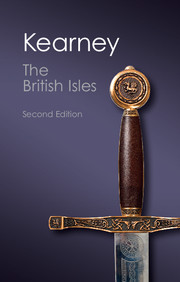Book contents
- Frontmatter
- Contents
- List of illustrations
- List of maps
- Preface to the first edition
- Preface to the second edition
- Map: the British Isles
- Introduction
- 1 The Celtic societies of the British Isles
- 2 The impact of Rome on the British Isles
- 3 The post-Roman centuries
- 4 The Vikings and the fall of the Old Order
- 5 The Norman and post-Norman ascendancy
- 6 The decline of the post-Norman empire
- 7 The making of an English empire
- 8 The remaking of an empire
- 9 The Britannic melting pot
- 10 The rise of ethnic politics
- 11 Between the wars
- 12 Withdrawal from empire
- 13 Post-imperial Britain: post-nationalist Ireland
- Afterword
- Selected reading list
- Index
6 - The decline of the post-Norman empire
Published online by Cambridge University Press: 05 June 2014
- Frontmatter
- Contents
- List of illustrations
- List of maps
- Preface to the first edition
- Preface to the second edition
- Map: the British Isles
- Introduction
- 1 The Celtic societies of the British Isles
- 2 The impact of Rome on the British Isles
- 3 The post-Roman centuries
- 4 The Vikings and the fall of the Old Order
- 5 The Norman and post-Norman ascendancy
- 6 The decline of the post-Norman empire
- 7 The making of an English empire
- 8 The remaking of an empire
- 9 The Britannic melting pot
- 10 The rise of ethnic politics
- 11 Between the wars
- 12 Withdrawal from empire
- 13 Post-imperial Britain: post-nationalist Ireland
- Afterword
- Selected reading list
- Index
Summary
The end of the thirteenth century saw the greatest extent of the post-Norman Edwardian empire of the British Isles. In Wales, Edward I's castles symbolised the establishment of royal authority over the last autonomous Welsh kingdom. Wales was now divided between marcher lordships in the south and west and a principality in the north-west where royal castles dominated the coastline from Harlech northwards. In Ireland, the royal justiciar John Wogan, sitting at Ardfert in Kerry, heard a plea concerning land at Dunquin. Royal power was not confined to Dublin and the east coast but extended to remote areas in the southwest. In Scotland, Edward, acting as overlord, had appointed guardians to decide upon the succession to the Scottish Crown. In England, the king seemed well able to cope with any opposition. The main problems seemed likely to arise in Gascony which Edward held as the vassal of the king of France.
As we now know, none of this proved to be permanent. Wogan's court in 1307 was the last royal assize to be held in Kerry for three centuries. In Scotland, Robert Bruce, whose father had fought with Henry III at the battle of Lewes, defeated the forces of Edward II at Bannockburn (1314). The conquest of Wales seemed to have succeeded but even here, at the end of the fourteenth century, Owain Glyndwr exposed the shallow foundations of Edward I's success.
- Type
- Chapter
- Information
- The British IslesA History of Four Nations, pp. 132 - 156Publisher: Cambridge University PressPrint publication year: 2012



